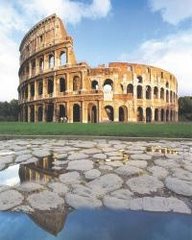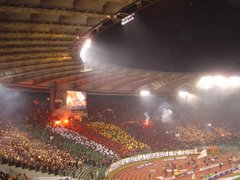Baroque Rome
If there is a period in art that can be said to have left its nature indelibly impressed on the city of Rome, this is the Baroque. The concrete expression of the triumphant Church that managed to overcome the crisis caused by the Protestant Reformation, the Baroque is the style of theatricality, wonder and amazement par excellence that emotionally involves the viewer. During the 17th century palaces, fountains, squares and churches were created, totally invading the city and giving it a new face which, today still, sets it apart in the world.
Throughout this itinerary, two names are alternately repeated: those of the two great and undisputed protagonists of this season, Bernini and Borromini who, perhaps because of the rivalry that characterised their relationship, both proved to be authentic geniuses.
The itinerary begins with the church of Santa Maria della Vittoria, where it is possible to admire a true masterpiece, the amazing Ecstasy of St. Theresa carved by Gian Lorenzo Bernini. Situated in the Cornaro Chapel, to the left of the transept, the work is conceived in a theatrical manner, respecting the words of St. Theresa of Avila who, to describe the moment when an angel pierced her heart, wrote that she had felt "inflamed by the love of God". The "staging" of the work is accentuated by the presence, in side balconies, of several members of the Cornaro family, who are the privileged spectators of an experience in which all the faithful are invited to participate.
In the 18th century the sculpture was particularly criticised for being too sensual, so much so that the Marquis de Sade found it hard to believe that Theresa was really a saint and De Brosses, a French man of letters, even stated, "If this is divine love, I know it well".
Next, the design for the church of San Carlo alle Quattro Fontane, on Via del Quirinale. is by Francesco Borromini. The strange, fanciful shapes of the architectural elements, as well as the continuous alternation of concave and convex lines in the decorative elements, were achieved thanks to the exclusive use of stucco, a particularly ductile material that was very suitable - more than marble - for the fantastic designs of the architect.
Borromini managed to create an absolute masterpiece, in spite of the extremely small dimensions of the church. It is said that the entire surface of the church is as large as a single supporting column of the dome of St. Peter's!
Continuing along the street, on the same side as San Carlino, there stands the church of Sant'Andrea al Quirinale, a masterpiece by Bernini.
Called the "pearl" of the Baroque because of the precious materials used in its construction, the church was the building to which Bernini felt closest. During the last years of his life, in the later afternoon, he would have himself taken to the church to admire the light that, filtered by the windows, was reflected on the marble walls and gold an stucco decorations.
Gian Lorenzo Bernini was also responsible for two works in the Palazzo del Quirinale: the benediction loggia and the circular tower, added as a defensive bulwark at the time of Pope Urban VIII.
Originally a 16th-century suburban residence, the palazzo del Quirinale fwas later chosen as the pope's summer residence thanks to the salubrity of the air and the closeness to the centre of the city.
After becoming the luxurious royal palace of the Savoia, today it is the seat of the Presidency of the Republic. The palace may be visited every Sunday morning, from 8.30 a.m. to 12.30 p.m., while every Sunday afternoon at 4 p.m., in the square in front of it, the solemn Changing of the Guard takes place, accompanied by a band concert.
Across from it are the Papal Stables, recently restructured by architect Gae Aulenti to hold important art exhibitions. From the coffee shop, set up inside the exhibition space, one of the most spectacular views over the city can be enjoyed.
Descending from the Quirinal along Via della Dataria and going past Via del Corso, a visit to the church of Sant'Ignazio is worthwhile, even if it contains no works by either Bernini or Borromini. The huge ceiling, frescoed by Father Andrea Pozzo, who created an architecture which opens up into the sky where St. Ignatius is received and glorified, is in fact one of the last and astounding expressions of Baroque painting. An incredible illusion is created by the fake architectural structures that give the idea of a space that extends forever.
But even greater is the amazement before the fake dome. It is a trompe-l'oeil effect done in perspective in such a way as to be seen by the congregation arranged along the nave. In order to admire the dome, painted on canvas, you can stand on the porphyry disk in the centre of the nave. Instead, to grasp the visual illusion, it is necessary to move towards the transept! The mind and hands behind this masterpiece is Andrea Pozzo, a Jesuit priest, painter, architect and mathematician who also worked as a cook for his religious order.
Before continuing the visit, you should stop to admire the small but lovely little square in front of the church. When, in 1727, the architect Filippo Raguzzini designed the lively buildings, he was criticised for having created a square in the shape of a "canterano" (chest of drawers), a piece of furniture much in vogue at the time. In reality, the space today appears as one of the most successful rococo creations. The Via del Burrò, which winds behind one of the buildings, takes its name from bureaux, i.e. the French offices that were housed in those buildings.
At Via dei Bergamaschi 59 there is a shop, Tulipani bianchi, where two amicable young Swiss people, Monika e Franz, create extremely original bouquets and elegant floral compositions.
At the nearby Piazza di Pietra 45, you can eat at the Osteria dell'ingegno (06-6780662). Also very popular are the American pub Miscellanea, which offers tasty salads for lunch, Via delle Paste, and the Pub incontro, at Via del Collegio Romano 6.
Going along Via del Seminario, after passing the Pantheon we turn left to reach Piazza Sant'Eustachio, where we can admire the dome of Sant'Ivo alla Sapienza, a masterpiece by Francesco Borromini.
The church was conceived to be the chapel of the University of Rome, founded in 1303 by Boniface VIII. The original seat was in Trastevere and, only in the mid-15th century, the university was transferred to the area of Sant'Ivo, where the building still stands today. The building was the seat of the "La Sapienza" University of Rome until 1935, when it was transferred to the "Città Universitaria".
The task of building the chapel of Sant'Ivo was originally assigned to Gian Lorenzo Bernini who, considering the work troublesome and difficult, entrusted it to Borromini, who instead created a structure as extraordinary as it was complex. The very original hexagonal plan takes up, in a schematised manner, the bee symbol of the Barberini family who commissioned the work. Also extraordinary is the dome, with an unusual spiral shape culminating with a crown of flames. It is the symbol of charity, the main virtue of St. Ives, protector of lawyers, who placed himself free of charge at the service of the poor and defenceless, thus becoming the "poorman's lawyer". The lantern of the dome recalls the valve of a mollusc which Borromini kept in his shell collection. It is thus probable that the artist was inspired, in his design for the bejewelled crown topping the building, by the elongated shape of the mollusc!
If you would like a good cup of coffee, don't miss the Caffè Sant'Eustachio, Piazza Sant'Eustachio 82, while at no. 54 is Camilloni, famous for its pastries and home-made ice-cream.
After a stop at Piazza Navona, always a beautiful setting for festivities, shows and processions, the itinerary on the Baroque can only end at the Vatican, where Bernini left countless specimens of his talent, starting from the spectacular Colonnade of St. Peter's Square. The elliptical shape, symbolising the Church's embrace of all of mankind, is defined by a series of 284 columns arranged in four rows.
If, however, you stand on one of the two focuses of the ellipse, marked by a granite disk, it seems that the colonnade is made up of only a single row of columns!
At the end of the right-hand arm of the colonnade, two Swiss Guards stand watch before the Scala Regia.
Skilfully exploiting the little space at his disposal, the artist managed to give the illusion of a much bigger staircase through the use of optical devices. Inside the basilica, also, Bernini's ingenious inventions never cease to amaze.
The huge space under the dome was occupied by the gigantic Baldacchino, 29 metres high (like Palazzo Farnese and the Louvre), whose twisted columns were cast of bronze taken from the Pantheon, a fact that immediately became the subject of the famous pasquinade "Quod non fecerunt barbari, fecerunt Barberini" (What the Barbarians did not do, the Barberini did).
The Baldacchino was erected over the altar, which in turn was placed exactly over the spot where, according to tradition, St. Peter is buried.
On the bases of the bronze columns supporting the Baldacchino, it is possible to see the shields with the Barberini bees.
A closer examination reveals, however, that in reality they show the sequence of expressions of pain on the face of a woman giving birth. Going around the monument clockwise, seven different moments of pregnancy can be seen, up to the smiling face of a baby. Bernini intended, evidently through the figure of Pope Urban VIII Barberini, to celebrate mankind who suffers while awaiting salvation.
At the back of the apse is the Cathedra, the large bronze chair, supported by four gigantic statues portraying the Doctors of the Church, which was created to hold the episcopal chair where Peter sat.
In reality, the cathedra, kept inside the Baroque monument, dates from the 9th century and is a gift from King Charles I (the Bald) to Pope John VII.
To give an idea of the dimensions of the cathedra, just imagine that 121 tons of bronze were used and that the wingspan of the dove of the Holy Spirit in the stained-glass window is 1.75 metres long. The tiaras of the Doctors of the Church, situated below, are also about two metres high.
Bernini also did the funeral monuments for Popes Urban VIII Barberini and Alexander VII Chigi.
The latter situated in the left transept, originally had the statue of Truth carved nude; but the pope, judging the female figure scandalous, had it covered with a bronze robe.
Bernini, who by then was on in years, in spite of his objections, had to surrender before the pope's request and see his work modified.
The door at the bottom of the monument is the Door of Death, symbolised by the macabre skeleton with hourglass in hand, through which all mortal beings must pass sooner or later.












